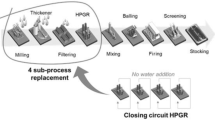Abstract
High-pressure grinding rolls (HPGR) are an accepted, but continuously expanding, comminution technology. The copper industry has a growing need to process harder ores with progressively lower grades, more challenging metallurgy and increasing demand for efficient bacterial leaching applications. This has resulted in a major focus on HPGR use in a crushing circuit. If the industry is to increase leach extraction while lowering energy costs in high-throughput hydrometallurgical operations, HPGR will be of inherent significance. The following paper summarizes test work on copper leach ores utilizing the benefits of HPGR comminution, while increasing several critical metallurgical parameters. Based on the current work and previous investigations, it was found that HPGR comminution within a crushing circuit, in specific instances, can result in 2 − >10% increases in copper extraction. The tested variables are crush size, rock type and copper mineralogy dependence. Various other process parameters may also be optimized.
Similar content being viewed by others
References
Baum, W., and Knecht, J., 1994, Optimizing refractory and oxide gold ore operations with high-pressure grinding rolls,” SME Pre-Print 94-12.
Baum, W., Patzelt, N., and Knecht, J., 1996a, “The use of high pressure grinding rolls for optimization of copper leaching,” SME Pre-Print 96-68.
Baum, W., 1996b, “Optimizing copper leaching/SX-EW operations with mineralogical data,” SME Preprint 96-84, 7 pp.
Baum, W., Patzelt, N., and Knecht, J. 1997, “Metallurgical benefits of high-pressure roll grinding for gold and copper recovery,” SME Denver Special Proceedings Comminution Practices, Kawatra, S.K. ed., pp. 111–116.
Baum, W., 1998, “Copper mineralogy and extraction problems. How to reduce your losses,” Randol Copper Hydromet Roundtable’ 98, Vancouver, Proceedings, pp. 41–51.
Campbell, J., 2005, Verbal report from site visit at the Damiana leach operation.
Esna-Ashari, and Kellerwessel, H., 1988, “Roller press comminution improves heap leach recovery,” Randol Gold Meeting Scottsdale, AZ, Proceedings, pp. 50–53.
Freeport-McMoRan Technology Center, 2008, “Internal report — HPGR microfracture study,” unpublished, 4 pp.
Friedrich, J.H., and Baum, W., “The use of high-pressure roll grinding for the treatment of low-grade and refractory gold ores,” Hidden Wealth, Johannesburg, South African Institute of Mining and Metallurgy, 1996, pp. 125–130.
Herkenhoff, E.C., and Dean, J.G., 1987, “Heap leaching: agglomerate or deslime?” Eng. Mining Journal, June 1987, pp. 32–39.
Klingmann, L., 2005, “Soledad Mountain Project — flowsheet development and benefits of the HPGR,” Proceedings of the Randol Innovative Metallurgy Forum 2005, Perth.
Klymowsky, R., Patzelt, N., Knecht, J., and Burchardt, E., 2006, “An overview of HPGR technology,” Proceedings of the SAG Conference, Vancouver, Vol. 4, pp. 11–26.
Knecht, J., Friedrich, J., and Baum, W., 1998, “HPGR as a processing tool for gold and copper leaching, flotation and gravity separation,” Paper presented at the Australian Comminution Conference.
Lin, C. and Miller, J., 2010, “Particle damage during breakage using high resolution X-ray Micro CT,” presentation at the SME Annual Meeting, Phoenix, AZ, abstract.
Marsden, J., 2008, “Energy efficiency and copper hydrometallurgy,” SME Hydrometallurgical Symposium Phoenix, Proceedings.
McNab, B., 2006, “Exploring HPGR technology for heap leaching of fresh rock gold ores,” HR Crushing and Grinding Conference, 2006, Townsville, pp. 1–26.
Patzelt, N., Knecht, J., and Baum, W., 1995, “Cost efficiency and operational features of high pressure grinding rolls in gold plant,” Mining Engineering, June, pp. 254–529.
Patzelt, N., Knecht, J. and Baum, W., 1997, “The metallurgical potential of high-pressure roll grinding,” Proceedings of the XX IMPC, Aachen, Germany, pp. 155–164.
Patzelt, N., Klymowsky, R., Knecht, J., and Burchardt, E., 2005, “HPGRs for Hard Rock Applications,” Proceedings of the Randol Innovative Metallurgy Forum 2005, Perth.
Phelps Dodge Process Technology Center, 2001, “Internal report — Ore leach testing HPGR study,” unpublished, 18 pp.
Phelps Dodge Process Technology Center, 2003, “Internal report — Ore leach testing HPGR study,” unpublished, 6 pp.
Scott, T., 2005, “HPGR for heap leach at St Ives,” Proceedings of the Randol Innovative Metallurgy Forum 3005, Perth.
von Michaelis, H., 2005, “Real and potential metallurgical benefits of HPGR in hard rock ore processing,” Randol HPGR Workshop, Perth, pp. 1–9.
Author information
Authors and Affiliations
Additional information
Paper number MMP-10-047.
Discussion of this peer-reviewed and approved paper is invited and must be submitted to SME Publications Dept. prior to November 30, 2011.
Rights and permissions
About this article
Cite this article
Baum, W., Ausburn, K. HPGR comminution for optimization of copper leaching. Mining, Metallurgy & Exploration 28, 77–81 (2011). https://doi.org/10.1007/BF03402391
Accepted:
Published:
Issue Date:
DOI: https://doi.org/10.1007/BF03402391




